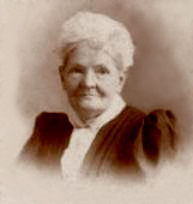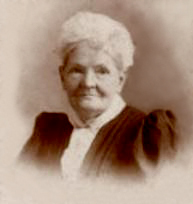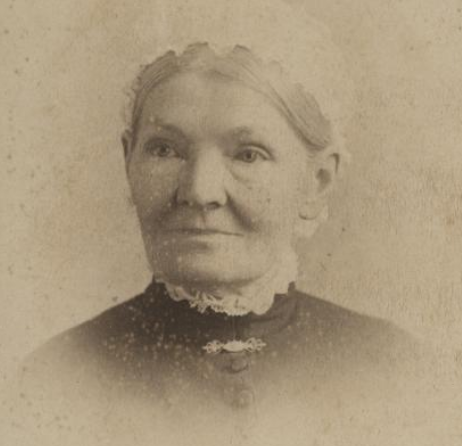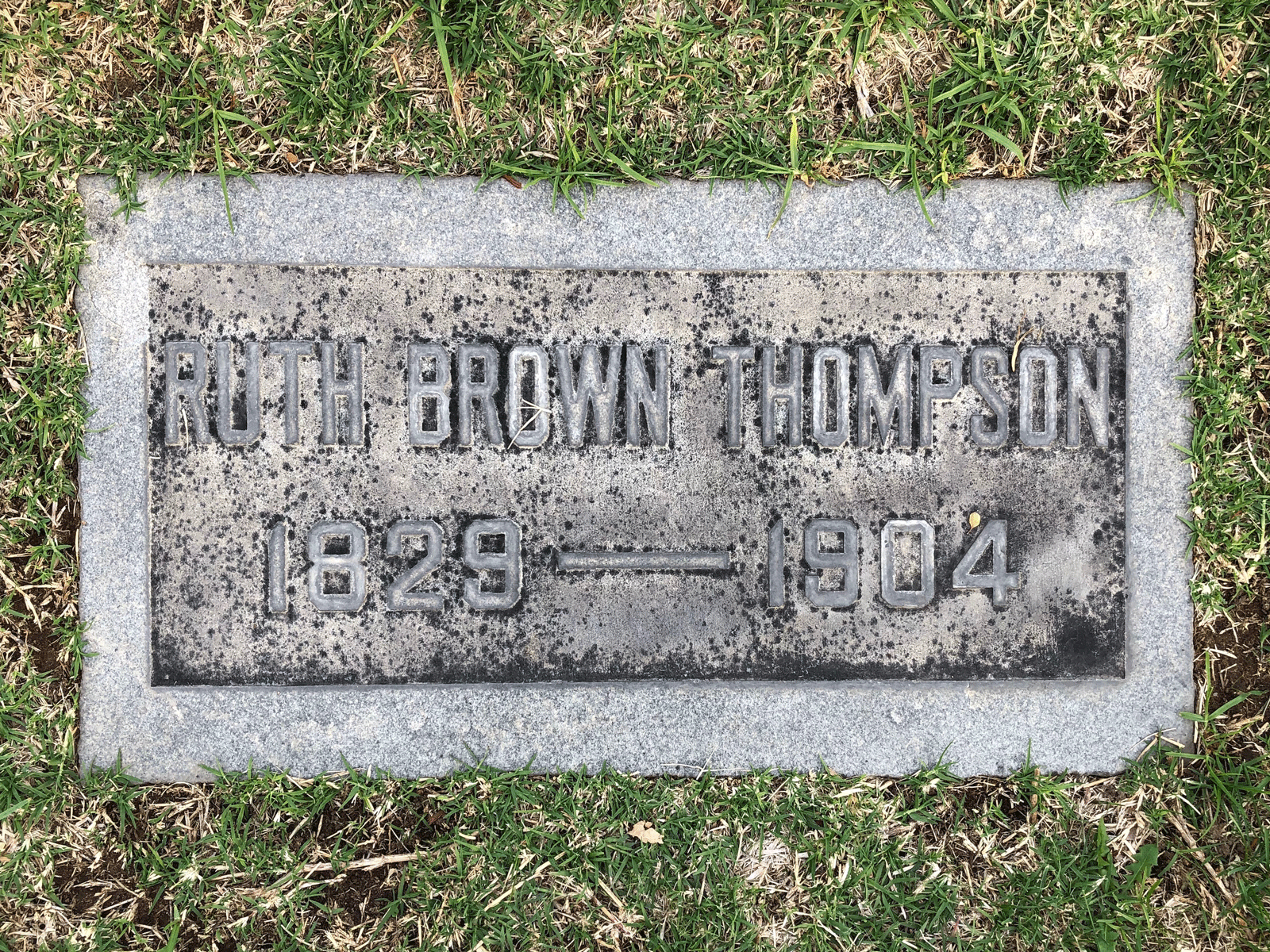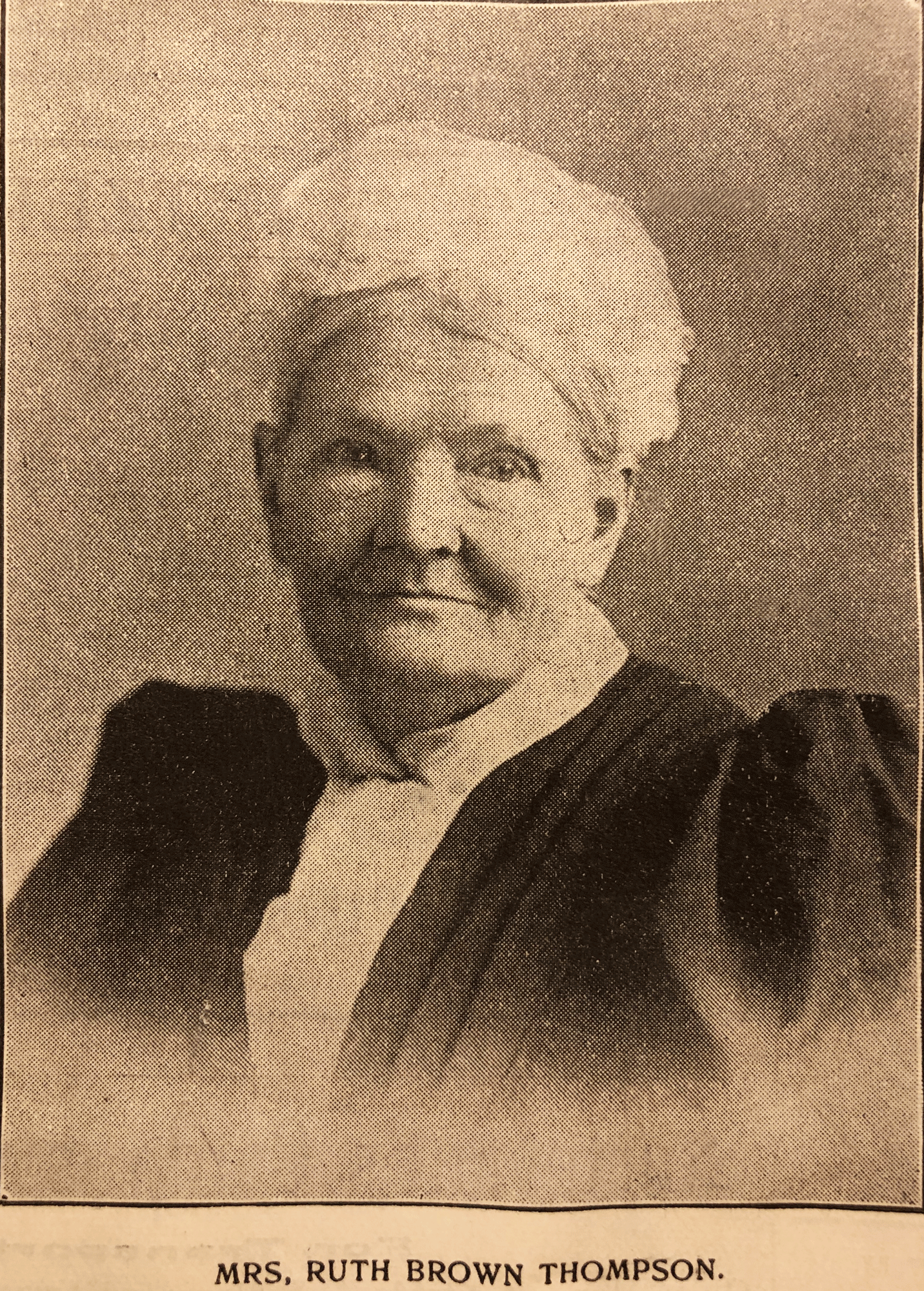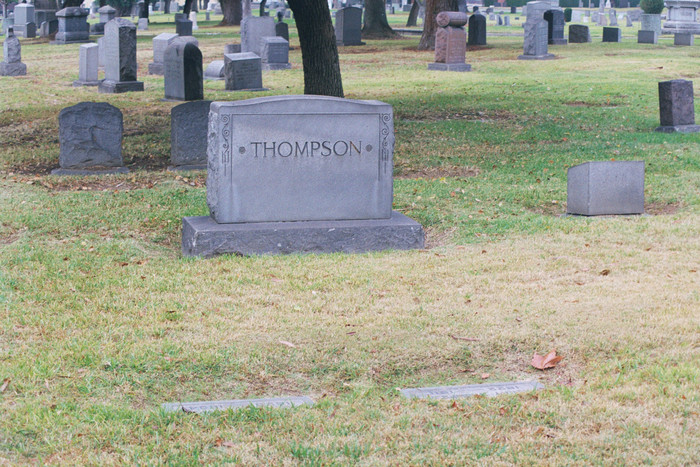OBITUARY I
The funeral of Mrs. Ruth Brown-Thompson, daughter of John Brown the negro liberator of Harper's Ferry, who died yesterday morning, will take place on next Monday afternoon at 2:30 o'clock at All Saints' Espicopal Church on North Euclid Avenue. The members of the Woman's Relief Corps will attend the services in a body. Floral offerings may be left at Ives & Warren's undertaking parlors up to noon on Monday, as it will be imppossible to receive all of them at the late residence of the deceased at No. 277 South Fair Oaks Avenue.
CROWDS ATTEND FUNERAL TODAY
Crowds of people attended the funeral at half past 2 o'clock today of Mrs. Ruth Brown Thompson, daughter of the liberator, which was held at All Saints' Episcopal Church, many arriving long before the doors were opened. Rev. William MacCormack, rector of the church read the short, simple service and there was no music. The church had been beautifully decorated by the teachers and pupils of the Garfield school in which Miss Mary Thompson is the beloved teacher of the sixth grade, and this grad helped especially in the work. the chancel was banked with greenery and a hedge of feathery papyrus and umbrella grasses. Great baskets of violets and roses and other floral offerings of friends were grouped effectively about the chancel.
Two immense American flags draped the choir screens and were caught up with ivy. Palms were also used. Over the pews reserved for the family were caught ivy wreaths. Festoons of evergreen were also used about the church. The W.R.C. attended in a body, fully fifty being present.
The floral remembrances were many and very beautiful. Among them were a large piece of roses and ferns from the Garfield school; a wreath from the mothers of the Garfield Child Study Circle; an immense basket of violets and smilax from Miss Thompson's class, the sixth grade of the Garfield; violets and hyacinths from the teachers of the Garfield; a large piece in white of gates ajar from the W.R.C.; a large and beautiful wreath of violets and hyacinths from the Afro-American League of Pasaedena; large cluster of violets from the Altar Chapter of All Saints' Church; Mrs. James A. Garfield, widow of the martyred President, sent carnations. Mrs. Robert J. Burdette sent flowers, Mrs. L. A. Costell sent cyca palm leaves, Mrs. Royce purple bell flowers, while there were also others that came in later, the casket being nearly covered with the fair blossoms.
Acting as pallbearers were Dr. Weir, H. H. Massey, R. H. Williams, Mr. Perring, A. K. Nash, W. R. Shepard.
At the grave Mrs. Minnie Porter Baldwin sang very sweetly Cardinal Newman's beautiful hymm, "Lead Kindly Light," and the short impressive service ended with the low toned prayer.
Because of a special wish of Mrs. Thompson's the family will not wear mourning for her and they felt that indeed, there is no need to show outward sign of the deep pain they feel at losin so noble and loving a spirit from their midst, rather wishing to dwell on her greater happiness in being reunnited with those gone before. It was also because of her wish to have all things in connection with her life most simple that they chose to surround her in death with the simplest possible service.
The Western Home (magazine, published monthly), Vol. 1, Number 6, P. 1 and P. 4-6
July, 1901 issue
RUTH BROWN THOMPSON
ANNIVERSARY OF HER WEDDING WAS CELEBRATED AT PASADENA, CAL., WEDNESDAY P. M., SEPTEMBER 26, 1900.
A HAPPY COMPANY assembled to celebrate the golden wedding of Mrs. Ruth Brown Thompson, daughter of John Brown, the martyr, and her husband, Henry Thompson.
A large flag was stretched over the entrance to their home and seats arranged under the spreading palms. Mrs. Thompson, greatly to the regret of all, was not able to join the out-door circle, but was reclining on her bed in hearing distance of the speakers. Their faithful daughter, Miss Mamie Thompson, the only child at home, is the comfort of their old age. She supports her parents, both of whom are somewhat feeble, by teaching in the Pasadena public schools.
The guests duly appreciated the beautiful souvenir cards presented by the family, bearing the simple inscription, “Ruth Brown, Henry Thompson. North Elba, N. Y., Sept. 26, 1850; Pasadena, Cal. 1900.” Appropriate remarks were made by a number of persons present. Dr. H. A. Reid, master of ceremonies, opened the program by giving very interesting items of Pasadena history connected with the Brown family. In speaking of the funeral of Owen Brown, Mrs. Thompson’s brother, he referred to the fact that the pall bearers were all persons who were associated in some way with John Brown, and that two of them were present on this occasion - Major H. A. Rust and James Townsend, the latter now in his ninetieth year.
Major Rust, after offering congratulations to the aged pair, said, “The past fifty years record many wonderful events in which it has been your fortune to have borne an active part. We, the American people, are much given to hero worship; we have recently gone wild because we have seen a man successfully discharging his duty under trying circumstances. Yet much of this honor is ephemeral in nature. We see here to-day our friends, Henry and Ruth Brown Thompson, veterans of the anti-slavery cause. They, with their associates, all plain farmers, had that high moral purpose and true courage which enabled them to make such sacrifices of time, comfort, personal effects - yes, and life - as no other American family have done.”
He then read what the great State of New York has done to perpetuate with honor the memory of John Brown, the liberator, by securing the farm at North Elba, where the hero’s remains are buried, and providing amply for the care of his grave and that of his associates. He also read a letter written by John Brown to his sisters, Mary and Elizabeth, two days before his death.” Of this letter he said, “I am sure those of you who know little of him will see in this letter the sincerity and high purpose of the man who led his followers by his example and effort to do right.” Major Rust also assisted John Brown in removing the stone that had been erected in memory of his grandfather to North Elba, where it now stands, with a number of inscriptions added in memory of other members of the family.
Mr. James Campbell, in speaking of the wonderful changes, social, financial and political which had occurred during the fifty years of Mr. and Mrs. Thompson’s married life, said: “Fifty years ago it required a high order of moral courage to declare opposition to slavery, and we now honor those who were brave and unselfish enough to lay down their property, their reputation and their lives, upon the altar of freedom. This John Brown and his noble compatriots did, and we do well to honor them. But, while doing honor to the brave men and women who preserved our nation from destruction a generation ago, is it not our duty to preserve unimpaired the blessings of free government handed down to us.”
Mrs. Nelson Weatherton, who represented the colored people of Pasadena and vicinity, spoke in a very interesting way, expressing the conviction that the future would demonstrate that John Brown was a deliverer to her race, as also that the time would come when his love, service and martyrdom for them would be truly appreciated by them.
Rev. S. H. Taft, of Santa Monica, who knew John Brown, and whose memorial sermon, given before his congregation in Martinsburg, New York, in December, 1859, has had a wide circulation, said in part, “We are met today to congratulate Mr. and Mrs. Thompson on their long and happy married life and to wish for them the rich blessing of continued peace and an unfaltering trust in the Heavenly Father’s love and care. While the occasion of this social gathering is the fiftieth anniversary of Mr. and Mrs. Thompson’s wedding, it very naturally calls to mind the tragic scenes through which the entire Brown family have passed since the quiet wedding celebrated in North Elba, N. Y., fifty years ago. So the exercises take on a double memorial character, in which those assembled to congratulate the venerable couple on their long and eventful life, also gratefully and reverently call to mind the consecration, fidelity and martyrdom of Mrs. Brown’s father, by reason of which John Brown wrought so gloriously for universal freedom and won an undying name as one of the world’s redeemers. The half century intervening between 1850 and 1900 has witnessed wonderful events and changes throughout the world, so wonderful as to bewilder the mind in their contemplation: The discoveries in archaeology and science have been marvelous, and in no other half century of the world’s history has there been an exhibition of such mastery of mind over the forces of nature, nor has any other period of time witnessed more persistent, and often tragic, contests between the conflicting social and moral forces of the world. A Russian emperor, two presidents of the United States, an Austrian empress and an Italian king have been assassinated. But none of these events so vitally affected the world’s moral and political trend as the execution of John Brown, who has well been called ‘liberty’s martyr.’ I fully endorse what Brother Campbell has said of our duty to emulate the spirit of self sacrifice and consecration which glorifies the names and work of the abolitionists of fifty years ago, and devote ourselves with like fidelity to the work of abolishing that greatest sin against God and crime against manhood - the licensed poison drink habit. It remains to be seen whether the American people will respond to this call of duty, by delivering the spoiled out of the hands of the spoiler, or will, instead, invoke upon the nation the disaster and anguish which preceded the overthrow of slavery.”
At the close of the ceremonies a purse of money, contributed by societies and individuals, was presented to the family. Mr. H. N. Rust also entertained the company by showing a large collection of photographs of the Brown family and of the men associated with him in that heroic effort for the freedom of the slave. The evening shades fell on us too soon, the good nights were spoken, and sweet memories will linger with many of us, no doubt, when this aged pair have passed the valley shadows.
John Brown’s martyrdom no doubt figured largely in producing the stupendous result of the freedom of 40,000,000 slaves during the ten years from 1860 to 1870 throughout the world, not only the 5,000,000 in the United States of America, but also the 10,000,000 in Brazil and the 25,000,000 Russian serfs.
View them from whatever standpoint we may, the Brown family, John Brown, his associates and descendants, are a remarkable family. While John Brown’s tactics were military in their character, and he had much to do in that bloody and stormy conflict in Kansas and elsewhere, his son Jason, now living near Santa Cruz, Cal., is a peace man. The writer had a conversation with him some years ago, and was surprised to find him with deep-seated principles on the subject, so much as to accord with the “views” of the most non-combatant Friend. He also carried out these principles in practical life.
At one time the Pasadena people, wishing to show their appreciation of the family, raised a fund for him and his brother, who were living in the mountains in apparently destitute circumstances. It chanced to be at the time of the terrible earthquake which desolated Charleston, S. C. Notwithstanding, these sufferers were the southern people and many of them such as held the name of John Brown in contempt, yet these brothers could not use the donation for their own comfort, but immediately forwarded the $100 to their stricken enemies. In this act how strikingly they fulfilled the command of the Bible text,” If thine enemy hunger, feed him, if he thirst give him drink, for in so doing thou shalt heap coals of fire on his head.”
(Article written by) -ELIZABETH ROBERTS TOWNSEND
P. 6 - (an advertisement) - RUTH BROWN THOMPSON’S portrait on the first page is said to be a fine picture of this noble woman, whose father, John Brown, was known the world over as a brave and daring man, a hero, a martyr - to the colored race, a liberator. If you wish copies, leave your name and address with the publisher, or the Jackson Printing Co., 40 North Fair Oaks, with 25cents, and you will be made a subscriber to this paper one year. The sale of this issue will go towards cancelling the mortgage on her home. The portrait itself is worth that amount of money.
Contributed by: Chloe, Find A Grave Member # 47159257
OBITUARY I
The funeral of Mrs. Ruth Brown-Thompson, daughter of John Brown the negro liberator of Harper's Ferry, who died yesterday morning, will take place on next Monday afternoon at 2:30 o'clock at All Saints' Espicopal Church on North Euclid Avenue. The members of the Woman's Relief Corps will attend the services in a body. Floral offerings may be left at Ives & Warren's undertaking parlors up to noon on Monday, as it will be imppossible to receive all of them at the late residence of the deceased at No. 277 South Fair Oaks Avenue.
CROWDS ATTEND FUNERAL TODAY
Crowds of people attended the funeral at half past 2 o'clock today of Mrs. Ruth Brown Thompson, daughter of the liberator, which was held at All Saints' Episcopal Church, many arriving long before the doors were opened. Rev. William MacCormack, rector of the church read the short, simple service and there was no music. The church had been beautifully decorated by the teachers and pupils of the Garfield school in which Miss Mary Thompson is the beloved teacher of the sixth grade, and this grad helped especially in the work. the chancel was banked with greenery and a hedge of feathery papyrus and umbrella grasses. Great baskets of violets and roses and other floral offerings of friends were grouped effectively about the chancel.
Two immense American flags draped the choir screens and were caught up with ivy. Palms were also used. Over the pews reserved for the family were caught ivy wreaths. Festoons of evergreen were also used about the church. The W.R.C. attended in a body, fully fifty being present.
The floral remembrances were many and very beautiful. Among them were a large piece of roses and ferns from the Garfield school; a wreath from the mothers of the Garfield Child Study Circle; an immense basket of violets and smilax from Miss Thompson's class, the sixth grade of the Garfield; violets and hyacinths from the teachers of the Garfield; a large piece in white of gates ajar from the W.R.C.; a large and beautiful wreath of violets and hyacinths from the Afro-American League of Pasaedena; large cluster of violets from the Altar Chapter of All Saints' Church; Mrs. James A. Garfield, widow of the martyred President, sent carnations. Mrs. Robert J. Burdette sent flowers, Mrs. L. A. Costell sent cyca palm leaves, Mrs. Royce purple bell flowers, while there were also others that came in later, the casket being nearly covered with the fair blossoms.
Acting as pallbearers were Dr. Weir, H. H. Massey, R. H. Williams, Mr. Perring, A. K. Nash, W. R. Shepard.
At the grave Mrs. Minnie Porter Baldwin sang very sweetly Cardinal Newman's beautiful hymm, "Lead Kindly Light," and the short impressive service ended with the low toned prayer.
Because of a special wish of Mrs. Thompson's the family will not wear mourning for her and they felt that indeed, there is no need to show outward sign of the deep pain they feel at losin so noble and loving a spirit from their midst, rather wishing to dwell on her greater happiness in being reunnited with those gone before. It was also because of her wish to have all things in connection with her life most simple that they chose to surround her in death with the simplest possible service.
The Western Home (magazine, published monthly), Vol. 1, Number 6, P. 1 and P. 4-6
July, 1901 issue
RUTH BROWN THOMPSON
ANNIVERSARY OF HER WEDDING WAS CELEBRATED AT PASADENA, CAL., WEDNESDAY P. M., SEPTEMBER 26, 1900.
A HAPPY COMPANY assembled to celebrate the golden wedding of Mrs. Ruth Brown Thompson, daughter of John Brown, the martyr, and her husband, Henry Thompson.
A large flag was stretched over the entrance to their home and seats arranged under the spreading palms. Mrs. Thompson, greatly to the regret of all, was not able to join the out-door circle, but was reclining on her bed in hearing distance of the speakers. Their faithful daughter, Miss Mamie Thompson, the only child at home, is the comfort of their old age. She supports her parents, both of whom are somewhat feeble, by teaching in the Pasadena public schools.
The guests duly appreciated the beautiful souvenir cards presented by the family, bearing the simple inscription, “Ruth Brown, Henry Thompson. North Elba, N. Y., Sept. 26, 1850; Pasadena, Cal. 1900.” Appropriate remarks were made by a number of persons present. Dr. H. A. Reid, master of ceremonies, opened the program by giving very interesting items of Pasadena history connected with the Brown family. In speaking of the funeral of Owen Brown, Mrs. Thompson’s brother, he referred to the fact that the pall bearers were all persons who were associated in some way with John Brown, and that two of them were present on this occasion - Major H. A. Rust and James Townsend, the latter now in his ninetieth year.
Major Rust, after offering congratulations to the aged pair, said, “The past fifty years record many wonderful events in which it has been your fortune to have borne an active part. We, the American people, are much given to hero worship; we have recently gone wild because we have seen a man successfully discharging his duty under trying circumstances. Yet much of this honor is ephemeral in nature. We see here to-day our friends, Henry and Ruth Brown Thompson, veterans of the anti-slavery cause. They, with their associates, all plain farmers, had that high moral purpose and true courage which enabled them to make such sacrifices of time, comfort, personal effects - yes, and life - as no other American family have done.”
He then read what the great State of New York has done to perpetuate with honor the memory of John Brown, the liberator, by securing the farm at North Elba, where the hero’s remains are buried, and providing amply for the care of his grave and that of his associates. He also read a letter written by John Brown to his sisters, Mary and Elizabeth, two days before his death.” Of this letter he said, “I am sure those of you who know little of him will see in this letter the sincerity and high purpose of the man who led his followers by his example and effort to do right.” Major Rust also assisted John Brown in removing the stone that had been erected in memory of his grandfather to North Elba, where it now stands, with a number of inscriptions added in memory of other members of the family.
Mr. James Campbell, in speaking of the wonderful changes, social, financial and political which had occurred during the fifty years of Mr. and Mrs. Thompson’s married life, said: “Fifty years ago it required a high order of moral courage to declare opposition to slavery, and we now honor those who were brave and unselfish enough to lay down their property, their reputation and their lives, upon the altar of freedom. This John Brown and his noble compatriots did, and we do well to honor them. But, while doing honor to the brave men and women who preserved our nation from destruction a generation ago, is it not our duty to preserve unimpaired the blessings of free government handed down to us.”
Mrs. Nelson Weatherton, who represented the colored people of Pasadena and vicinity, spoke in a very interesting way, expressing the conviction that the future would demonstrate that John Brown was a deliverer to her race, as also that the time would come when his love, service and martyrdom for them would be truly appreciated by them.
Rev. S. H. Taft, of Santa Monica, who knew John Brown, and whose memorial sermon, given before his congregation in Martinsburg, New York, in December, 1859, has had a wide circulation, said in part, “We are met today to congratulate Mr. and Mrs. Thompson on their long and happy married life and to wish for them the rich blessing of continued peace and an unfaltering trust in the Heavenly Father’s love and care. While the occasion of this social gathering is the fiftieth anniversary of Mr. and Mrs. Thompson’s wedding, it very naturally calls to mind the tragic scenes through which the entire Brown family have passed since the quiet wedding celebrated in North Elba, N. Y., fifty years ago. So the exercises take on a double memorial character, in which those assembled to congratulate the venerable couple on their long and eventful life, also gratefully and reverently call to mind the consecration, fidelity and martyrdom of Mrs. Brown’s father, by reason of which John Brown wrought so gloriously for universal freedom and won an undying name as one of the world’s redeemers. The half century intervening between 1850 and 1900 has witnessed wonderful events and changes throughout the world, so wonderful as to bewilder the mind in their contemplation: The discoveries in archaeology and science have been marvelous, and in no other half century of the world’s history has there been an exhibition of such mastery of mind over the forces of nature, nor has any other period of time witnessed more persistent, and often tragic, contests between the conflicting social and moral forces of the world. A Russian emperor, two presidents of the United States, an Austrian empress and an Italian king have been assassinated. But none of these events so vitally affected the world’s moral and political trend as the execution of John Brown, who has well been called ‘liberty’s martyr.’ I fully endorse what Brother Campbell has said of our duty to emulate the spirit of self sacrifice and consecration which glorifies the names and work of the abolitionists of fifty years ago, and devote ourselves with like fidelity to the work of abolishing that greatest sin against God and crime against manhood - the licensed poison drink habit. It remains to be seen whether the American people will respond to this call of duty, by delivering the spoiled out of the hands of the spoiler, or will, instead, invoke upon the nation the disaster and anguish which preceded the overthrow of slavery.”
At the close of the ceremonies a purse of money, contributed by societies and individuals, was presented to the family. Mr. H. N. Rust also entertained the company by showing a large collection of photographs of the Brown family and of the men associated with him in that heroic effort for the freedom of the slave. The evening shades fell on us too soon, the good nights were spoken, and sweet memories will linger with many of us, no doubt, when this aged pair have passed the valley shadows.
John Brown’s martyrdom no doubt figured largely in producing the stupendous result of the freedom of 40,000,000 slaves during the ten years from 1860 to 1870 throughout the world, not only the 5,000,000 in the United States of America, but also the 10,000,000 in Brazil and the 25,000,000 Russian serfs.
View them from whatever standpoint we may, the Brown family, John Brown, his associates and descendants, are a remarkable family. While John Brown’s tactics were military in their character, and he had much to do in that bloody and stormy conflict in Kansas and elsewhere, his son Jason, now living near Santa Cruz, Cal., is a peace man. The writer had a conversation with him some years ago, and was surprised to find him with deep-seated principles on the subject, so much as to accord with the “views” of the most non-combatant Friend. He also carried out these principles in practical life.
At one time the Pasadena people, wishing to show their appreciation of the family, raised a fund for him and his brother, who were living in the mountains in apparently destitute circumstances. It chanced to be at the time of the terrible earthquake which desolated Charleston, S. C. Notwithstanding, these sufferers were the southern people and many of them such as held the name of John Brown in contempt, yet these brothers could not use the donation for their own comfort, but immediately forwarded the $100 to their stricken enemies. In this act how strikingly they fulfilled the command of the Bible text,” If thine enemy hunger, feed him, if he thirst give him drink, for in so doing thou shalt heap coals of fire on his head.”
(Article written by) -ELIZABETH ROBERTS TOWNSEND
P. 6 - (an advertisement) - RUTH BROWN THOMPSON’S portrait on the first page is said to be a fine picture of this noble woman, whose father, John Brown, was known the world over as a brave and daring man, a hero, a martyr - to the colored race, a liberator. If you wish copies, leave your name and address with the publisher, or the Jackson Printing Co., 40 North Fair Oaks, with 25cents, and you will be made a subscriber to this paper one year. The sale of this issue will go towards cancelling the mortgage on her home. The portrait itself is worth that amount of money.
Contributed by: Chloe, Find A Grave Member # 47159257
Family Members
Sponsored by Ancestry
Advertisement
Records on Ancestry
Sponsored by Ancestry
Advertisement
